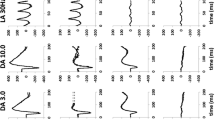Abstract
We developed a personal computer-based system for clinical electrophysiologic measurements. The computer interfaced with a commercially available A/D converter, a low-noise isolation preamplifier, filter circuits, pattern and Ganzfeld stimulators, and a hardcopy unit. Separate programs were developed for electroretinography (ERG), pattern ERG and simultaneus visual evoked potential (VEP), flash and pattern-shift VEP, and electro-oculographic measurements. The complete control of the applied hardware (eg, stimulus control, automatic gain, and filter selection) is a common feature of the computer programs. These programs provide oscilloscopic functions, overload protection, artifact elimination, averaging, automatic peak latency and amplitude determination, baseline correction, smoothing, and digital filtering. The results can be presented on matrix, laser printers, or digital plotters. The hardware components and the features of the driver software are demonstrated on normal and pathologic signals.
Similar content being viewed by others
References
De Waal BJ, Reits D, Spekreise H, Grimbergen CA. Implementation of a portable pattern stimulator and VEP/ERG recording system based on an APPLE microcomputer. Doc Ophthalmol Proc Series 1983; 37: 209–216.
Van Norren D, Van de Kraats J. Interactive computer program for clinical electrophysiology. Doc Ophthalmol Proc Series 1983; 37: 193–197.
Gunkel RD, Bergsma DR, Gouras P. A ganzfeld stimulator for electroretinography. Arch Ophthalmol 1976; 94: 669–670.
Rabin AR, Berson EL. A full-field system for clinical electroretinography. Arch Ophthalmol 1974; 92: 59–63.
van Heuningen R, Goovaerts HG, de Vries FR. A low noise isolated amplifier system for electrophysiological measurements: basic considerations and design. Med Biol Eng Comput 1984; 22: 77–85.
Berninger TA. The pattern electroretinogram and its contamination. Clin Vision Sci 1986; 1: 185–190.
Arden GB, Carter RM, Hogg C, Siegel I, Margolis S. A gold foil electrode: Extending the horizons for clinical electroretinography. Invest Ophthalmol Vis Sci 1979; 18: 421–426.
Salu P, Trau R. A new type of electrode for recording pattern electroretinograms and visual-evoked potentials simultaneously. Am J Ophthalmol 1983; 95: 555–556.
Rabiner LR, Gold B. Theory and Application of Digital Signal Processing. London: Prentice Hall; 1975.
Siegfried JB. Digital vs analog filtering of electrophysiological data utilizing microprocessors. Doc Ophthalmol Proc Series 1983; 37: 247–252.
Author information
Authors and Affiliations
Rights and permissions
About this article
Cite this article
Török, B. Microcomputer-based recording system for clinical electrophysiology. Doc Ophthalmol 75, 189–197 (1990). https://doi.org/10.1007/BF00146555
Accepted:
Issue Date:
DOI: https://doi.org/10.1007/BF00146555




